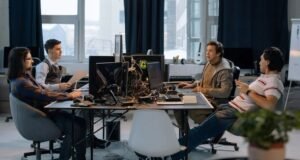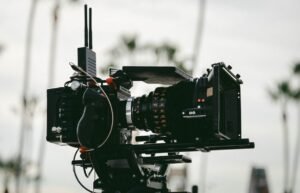AI Art and Its Impact on Artists
Artificial Intelligence (AI) has been revolutionizing various industries, and the art world is no exception. With advancements in AI technology, artists have begun exploring the possibilities of creating art using machine learning algorithms. This emerging field, known as AI art, is starting to have a significant impact on traditional art forms and artists themselves.
Key Takeaways
- AI art is emerging as a new form of artistic expression.
- Machine learning algorithms are used to generate art.
- AI art challenges the definition and authenticity of traditional art.
- Artists can incorporate AI into their creative process.
- AI art can inspire new artistic styles and techniques.
**AI art** involves using machine learning algorithms to generate artistic content, such as paintings, sculptures, music, and more. *By training AI models on large datasets of existing artworks, these algorithms can learn to mimic specific artistic styles or generate original compositions based on learned patterns.* This fusion of technology and creativity has sparked debates around the definition and authenticity of art, leading to exciting discussions within the artistic community.
AI art can be seen as both a collaboration and a competition between humans and machines. While the algorithms can produce impressive pieces, *it is the artist’s role in curating, refining, and adding a human touch that brings the final artwork to life.* This collaboration between AI and artists has the potential to spur innovation and push the boundaries of traditional art forms.
The Impact of AI Art on Artists
AI art has brought about several significant implications for artists:
- Artists can **augment their creative process** by utilizing AI algorithms to generate ideas or provide inspiration.
- AI artists can create new, **unique artistic styles** that were previously unexplored or challenging to achieve manually.
- AI art allows for **automated creation**, enabling artists to focus on other aspects of their craft.
- AI-generated art can **challenge and redefine** the role of artists in the creation of traditional art forms.
With the rise of AI art, it is crucial for artists to stay informed about the advancements in this field and embrace the opportunities it presents. By incorporating AI into their creative process, artists can explore new possibilities, expand their artistic horizons, and foster innovation.
Examples of AI Art in Practice
| Artist | AI Technique Used |
|---|---|
| Obvious | Generative Adversarial Networks (GANs) |
| Robbie Barrat | Neural Style Transfer |
| Anna Ridler | Machine learning with datasets |
AI artists like **Obvious**, **Robbie Barrat**, and **Anna Ridler** have gained attention for their exceptional AI-generated artworks. Obvious gained recognition for selling a print produced by a GAN for a whopping $432,500 at an auction. Robbie Barrat, on the other hand, is known for using neural style transfer to generate captivating and unique art pieces. Anna Ridler combines machine learning techniques with datasets to explore and question various aspects of our society and culture.
Challenges and Future Prospects of AI Art
- **Challenges**: AI art raises questions about the originality and authenticity of the artwork, blurring the distinction between human and machine creations.
- **Future Prospects**: AI art has the potential to create entirely new artistic styles and techniques, pushing the boundaries of what is possible in traditional art forms.
| Benefits | Challenges |
|---|---|
| AI inspires new artistic styles and ideas. | AI raises concerns about the originality and creativity of human artists. |
| AI helps artists experiment with new techniques. | AI-generated artworks can be seen as less authentic or valuable by some. |
| AI automates certain repetitive tasks in the artistic process. | AI art challenges the traditional definition of art and the role of artists. |
AI art undoubtedly poses challenges to the art world, but it also opens up a realm of fascinating possibilities. As technologies continue to advance, the boundaries between human creativity and artificial intelligence will continue to blur, ultimately leading to a new era of artistic innovation and exploration.
AI Art: The Emergence of a New Artistic Landscape
The realm of AI art is constantly evolving and expanding, presenting artists with exciting opportunities and challenges. As AI continues to revolutionize the art world, artists must adapt and embrace these technologies to remain at the forefront of creativity and innovation. By harnessing the power of AI, artists can explore uncharted territories and forge ahead into a new artistic landscape.

Common Misconceptions
Misconception 1: AI Art will replace human artists
One common misconception about AI art is that it will eventually replace human artists and make their skills obsolete. However, this is far from the truth. While AI technology is capable of creating impressive artworks, it lacks the emotional depth and intuition that human artists possess. AI art may excel at generating algorithmically-driven designs, but it cannot replicate the unique perspectives and personal experiences that human artists bring to their work.
- AI lacks emotional depth and intuition present in human art.
- AI art cannot replicate the unique perspectives and personal experiences of human artists.
- AI excels in algorithmically-driven designs rather than creating meaningful art.
Misconception 2: AI Art devalues human creativity and originality
Another misconception is that AI art devalues human creativity and originality. It is often believed that since AI algorithms can generate countless iterations of artwork, the value of individual artworks decreases. However, AI art should be seen as a tool or medium that artists can incorporate into their creative process. Rather than replacing creativity, AI can enhance it by offering new possibilities and pushing boundaries.
- AI art can be seen as a tool that complements human creativity.
- AI creates new possibilities for artists to explore and push boundaries.
- AI-enhanced art can provide unique and innovative experiences for viewers.
Misconception 3: AI Art is easy and requires little skill
Many people mistakenly assume that creating AI art is easy and requires little skill. However, developing AI algorithms and training models to generate meaningful and aesthetically pleasing artwork is a highly complex and technical process. Artists who work with AI must have a deep understanding of the technology and possess the creative ability to guide and curate the output of the algorithms.
- Creating AI art involves a complex and technical process.
- Artists working with AI must have a deep understanding of the technology.
- Curation and creative guidance of AI algorithms is a skill in itself.
Misconception 4: AI Art lacks authenticity and genuine expression
One misconception surrounding AI art is that it lacks authenticity and genuine expression. It is often believed that AI-generated artwork is merely a replication of existing styles and lacks the emotional connection found in human-created art. While AI art is trained on existing data, it can still produce unique and surprising results. The ability to combine elements from different sources and create novel compositions can lead to unexpected expressions and aesthetics.
- AI-generated art can produce unique and surprising results.
- Combining elements from different sources can lead to unexpected aesthetics.
- AI art can challenge traditional notions of authenticity and expression.
Misconception 5: AI Art will lead to mass unemployment in the art industry
Lastly, there is a fear that AI art will lead to mass unemployment in the art industry, with AI algorithms taking over the creation process. While AI can automate certain aspects of art production, it also opens up new opportunities for artists. AI can assist in tasks such as generating preliminary sketches or suggesting color palettes, saving time for artists to focus on more creative and conceptual aspects. Additionally, AI art can create new roles and careers in areas such as AI art curation and collaboration.
- AI can automate certain aspects of art production, allowing artists to focus on creative aspects.
- AI art can create new roles and careers in AI art curation and collaboration.
- AI technology can be seen as a tool that augments human artistic abilities.

The Rise of AI Art
Artificial intelligence (AI) has revolutionized many industries, and the world of art is no exception. AI algorithms have become increasingly capable of creating stunning and thought-provoking artworks. This has sparked a significant impact on artists and their creative processes. Here, we explore ten fascinating aspects of AI art and its profound influence on artists.
1. AI Art Sales at Auction
A fascinating aspect of AI art is its increasing popularity at art auctions. In 2018, a painting created by an AI algorithm sold for a staggering $432,500 at Christie’s. This marked an important milestone in recognizing the value and artistic merit of AI-generated art.
2. Collaborative Creation
AI art offers artists a novel opportunity to collaborate with intelligent algorithms. Through the collaboration, artists can explore new creative avenues, merge human and machine creativity, and push artistic boundaries to previously unimagined realms.
3. Ethical Concerns
As AI art gains prominence, ethical concerns arise. One critical point of debate revolves around whether AI-generated art can truly be considered “original” or if it is merely an imitation of human artistic styles. This discussion challenges traditional notions of authorship and the uniqueness of artistic expression.
4. Disrupting Traditional Approaches
AI art disrupts traditional artistic methods by offering alternative ways of creating art. For instance, while human artists may manually paint for weeks to create a masterpiece, AI algorithms can generate remarkable pieces in a matter of minutes. This challenges the notion of time and effort invested in creating art.
5. Expanding Artistic Styles
Artificial intelligence enables artists to expand their creative repertoire by exploring new styles and techniques. AI algorithms can analyze vast amounts of artwork from different periods and generate unique combinations of various artistic styles, leading to the creation of stunning and innovative artworks.
6. The Role of the Artist
With the advent of AI art, the role of the artist is transforming. Artists are becoming more like curators and creative directors, guiding and refining the output of AI algorithms instead of solely being the hands behind a piece of art. Through this collaboration, artists maintain their unique artistic vision.
7. Generating Art from Data
AI art has the ability to transform raw data into captivating visual representations. Scientists and data analysts can use AI algorithms to generate insightful and visually striking data visualizations, making complex information more accessible and engaging to a broad audience.
8. Instant Feedback on Concepts
AI algorithms can provide artists with instant feedback and suggestions on their creative concepts. Artists can quickly experiment with different ideas, styles, and color palettes, allowing for rapid iterations and exploration without the need for extensive revisions.
9. Democratizing Art Creation
AI art holds the potential to democratize art creation. With accessible AI tools and platforms, aspiring artists who may have lacked formal training or resources can experiment with AI algorithms to bring their artistic visions to life. This empowers a more diverse range of creatives to engage in the art world.
10. The Future of AI Art
The future of AI art is incredibly promising and opens up countless possibilities. As AI algorithms continue to evolve and improve, AI-generated artworks may become even more intricate, imaginative, and emotionally resonant. The boundaries between human and AI art may further blur, making for a fascinating artistic landscape.
In conclusion, AI art has emerged as a transformative force, revolutionizing the art world and pushing artistic boundaries. From innovative styles and techniques to challenging traditional notions of authorship and creativity, AI-generated art has profound implications for both artists and the wider creative community. As technology continues to advance, the future of AI art holds immense promise, and its impact on artists and art enthusiasts alike will only continue to grow.
Frequently Asked Questions
What is AI art?
AI art refers to artworks created with the assistance or involvement of artificial intelligence technology. It involves the use of algorithms and computer systems to produce visual, auditory, or other artistic creations.
How does AI impact the art industry?
AI has a significant impact on the art industry by enabling new artistic techniques and expanding creative possibilities. It can assist artists in generating new ideas, automating certain processes, and pushing the boundaries of traditional art forms.
What are some examples of AI art?
Examples of AI art include computer-generated paintings, music compositions, poetry, and even interactive installations. AI algorithms can also analyze and interpret existing artworks to generate novel variations or styles.
Is AI art considered authentic or original?
The authenticity and originality of AI art are debatable topics. While the algorithms used in creating AI art are designed by humans, the actual output is often a collaboration between the artist and the AI system. Some argue that the involvement of AI makes the final artwork less original, while others consider it a new form of creative collaboration.
Does AI art replace human artists?
No, AI art does not replace human artists. It is a tool that can be employed by artists as a medium for creative expression. While AI can automate certain processes and generate novel ideas, the artistic vision and emotional depth brought by human artists remain essential in creating meaningful artworks.
How can AI benefit artists?
AI can benefit artists in various ways. It can help artists overcome creative blocks by providing new sources of inspiration and generating alternative ideas. AI tools can also automate repetitive tasks, allowing artists to focus more on conceptualization and expression. Additionally, AI can aid in the exploration of new artistic styles and techniques that would be otherwise challenging for human artists.
What are the ethical implications of AI art?
Ethical implications of AI art include concerns regarding intellectual property, authorship, and the potential devaluation of human creativity. It raises questions about the role of AI in the art-making process and the extent to which humans should retain control over artistic decisions.
Can AI art be considered as good as traditional art?
The evaluation of art, whether AI or traditional, is subjective and highly dependent on personal preferences and cultural contexts. While AI art can present unique and unconventional creations, the appreciation and interpretation often differ from that of traditional art forms.
Is AI art accessible to everyone?
AI art is becoming more accessible as AI tools and technologies advance. However, certain technical skills and resources are still required to properly utilize AI for artistic purposes. Nevertheless, efforts are being made to develop user-friendly AI tools that cater to a wider audience.
What does the future hold for AI art?
The future of AI art holds exciting possibilities. As AI algorithms advance, we can expect further integration of AI in art creation, interactivity, and immersive experiences. The relationship between AI and human artists will likely continue to evolve, leading to new forms of artistic expression and exploration.




